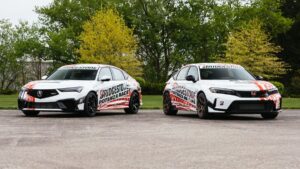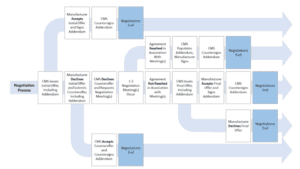Tesla Shattered Delivery Targets But Margins Remain The Question

Good morning! It’s Monday, July 3, 2023 and this is The Morning Shift, your daily roundup of the top automotive headlines from around the world, in one place. Here are the important stories you need to know.
1st Gear: Volume, Volume, Volume
Tesla moved 466,140 vehicles globally in the second quarter of 2023, when analysts expected about 448,000. Wall Street loves it when this happens, as evidenced by Tesla’s stock trending more than 6 percent up in premarket trading Monday. Courtesy Bloomberg:
“It’s a big beat,” Ben Kallo, a Robert W. Baird analyst, said by phone Sunday. “People were still bracing for another round of price cuts, and this big delivery number makes that less of a risk.”
The deliveries are the most ever in a quarter for Austin-based Tesla, and were up 83% from a year ago, when lockdowns hampered its operations in China. The company produced 13,560 more vehicles than it delivered in the quarter, after output exceeded sales by almost 18,000 cars in the first quarter.
“Everyone was worried about inventory build, and it looks like they’ve normalized,” Kallo said. “The delta between production and deliveries is shrinking, which is what Tesla said they would do.”
However, not everyone is fully convinced that the hit to margins in exchange for volume was really worth it. The skeptics are waiting to see what Tesla’s profit for the quarter looks like when it reports on July 19. The brand doesn’t appear to be supply constrained even with the rash of price cuts through the year, as Bloomberg’s Liam Denning wrote in an opinion piece:
There is one unsettling element from Sunday’s numbers: Tesla is still producing more vehicles than it is selling. While the gap is narrowing, this marks the fifth quarter in a row of excess production, for a cumulative total of just over 91,000 undelivered vehicles. At a notional cost of about $38,000 each — the implied average production cost in the first quarter — that’s almost $3.5 billion of finished inventory, with about $520 million added in the second quarter.
That matters because a surge in inventory fueled the big jump in working capital that savaged Tesla’s free cash flow in the first quarter. While there is unlikely to be as significant an increase this quarter, the continuing build-up of unsold vehicles will keep a lid on margins and cash flow. It also conflicts with the long-standing idea that Tesla is supply-constrained, which is doubly important given how much new manufacturing capacity is coming online.
Another catch to Tesla’s upbeat sales news is that BYD’s was better. The Chinese automaker widened its lead in its domestic market, having sold 700,244 battery EVs and plug-in hybrids over the same period, a personal best. About half of those were fully-electric cars.
2nd Gear: Wrangler’s Loss, Bronco’s Gain
Jeep folks have a reputation for loyalty, but Stellantis is testing that loyalty somewhat with a recent decision to allocate only plug-in hybrid versions of certain models to CARB-compliant states. Buyers who are either only interested in a pure ICE SUV or simply don’t have the money to drop on a 4xe Wrangler in those markets have to special order their vehicle — or hit up the Ford dealer across the street and look at a Bronco.
Stellantis’ allocation strategy is relatively fresh, but Automotive News spoke to experts and analysts about its possible ramifications for Jeep, and what Team Bronco stands to gain:
The car buying process can be complicated enough as it is. [Edmunds Director of Insights Ivan] Drury said adding more friction to the equation with allocation dependent on state regulations won’t help retailers or consumers.
“This causes question marks [and] just makes people puzzled,” Drury said. “I think for a lot of people they feel like they’re even getting some type of misinformation about the allocations, and they want to do more research about why is it only these states? It could be very puzzling, and I think that dealers will have to also be equipped with answering those questions and trying to provide those rationales for a customer.
“If you give them education behind that, you could try to curb some of that, and maybe convert into a sale, but they’re going have to have that educational component, too.”
Karl Brauer, executive analyst for iSeeCars.com, said the Wrangler went a couple decades without a direct competitor when the previous-generation Bronco was discontinued in 1996. Brauer said the new Bronco is a capable off-roader “that absolutely gives people who are considering a Wrangler an alternative that’s very, very appealing.”
Brauer said there’s definitely potential for someone who planned to buy the ICE Wrangler in a CARB state to switch to its competitor.
“Stellantis would have had a lot more leverage and flexibility with how they want to dole out Wranglers and not potentially lose customers in a pre-Bronco world,” Brauer said. “But we are in a Bronco world now, and that makes it undeniably riskier to increase the difficulty in getting a specific Wrangler model that a customer might want.”
Over the first quarter Bronco sales climbed 38 percent, to 32,430 units, while the Wrangler dropped 17 percent, to 37,971. Stellantis adjusted allocation in April, meaning those numbers mostly don’t reflect it being harder to buy ICE Wranglers in those 14 CARB states. Q2 should be more informative.
3rd Gear: Texas Won’t Take It Slow
Tesla’s home state of Texas is rushing to ensure that Tesla’s charging connector, or the North American Charging Standard, is installed in all future charging stations. To gain access to Texas’ federally allocated subsidies to build those stations, public charging companies there will have to include NACS. While most of these firms are on board with NACS, they’re less on board with it becoming a condition for access to government dollars. From Reuters:
But five electric vehicle charging companies, including operator ChargePoint Holdings and manufacturer ABB, and a clean energy association have written to the Texas Transportation Commission, calling for more time to re-engineer and test Tesla’s connectors.
Texas’ plan “risks the successful deployment” of the first phase of federal funds being rolled out, they said in the letter sent to the chairman of the commission on Thursday, which was seen by Reuters.
“Time is needed to properly standardize, test, and certify the safety and interoperability of Tesla connectors across the industry,” they said.
The source directly aware of the matter told Reuters that some of these organizations are planning to reach out to the federal government with the issue soon.
Of course, it wouldn’t be all that useful to build thousands of chargers without a standard that is going to be ubiquitous from 2025 onward. But then considering how unreliable public chargers already are, forcing these companies to adopt a new technology immediately seems like a poor move, especially if the state or federal governments want these terminals to last for a long time. Doing it right > doing it first.
4th Gear: Peugeot
Peugeot believes in its EVs, but also believes European customers are confused about forthcoming regulations — namely, when they’ll no longer have a chance to buy an ICE car or if there will be a carve out for synthetic fuel. In the meantime, it’s offering subscriptions for its first mass-market EV, the e-208. Courtesy Automotive News:
As part of its EV push, the brand is rolling out a pay-as-you-go program in Europe, where customers can pay a monthly and per-kilometer fee for its e-208 model.
Owned by auto giant Stellantis, Peugeot has seen EV sales remain solid despite competition from Chinese manufacturers, [CEO Linda] Jackson said in an interview. She added, however, that ongoing European Union debate over the details of the green transition is weighing on the shift to EVs.
Potential buyers are “slightly confused because there have been some mixed messages coming out” of the European Union about the use of e-fuels and the timeline to phase out combustion engines, she said.
Yet as the shift to EVs continues, European automakers are under growing pressure to make higher quality vehicles more cheaply. The competition has become more intense as inflation and a global slowdown set off aggressive price cuts by Tesla and others.
Peugeot CEO Linda Jackson also told the website that the brand is excited to introduce a “rectangular steering control center, inspired by videogames” by 2027. Floating a bad Tesla idea six years after Tesla tried it and four years after they walked it back: that’s the Stellantis way.
Reverse: Happy Birthday Seb
Today we wish a happy 36th to Sebastian Vettel, who was born on July 3, 1987. Here’s Elizabeth Blackstock’s story about the time she asked him to sign a blue flag and he delivered, with his heart-melting smile I’m sure.
Neutral: Happy Weird Monday
Are you working today? Are you really working today?



